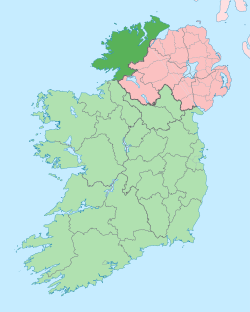Inver
Inver (Irish: Inbhear, meaning "estuary") is a small village in County Donegal, Ireland. It lies on the N56 National secondary road midway between Killybegs to the west and Donegal Town to the east. It is also a civil parish in the historic barony of Banagh.[1]
Inver Inbhear | |
|---|---|
Town | |
Inver and Inver Beach | |
 Inver Location in Ireland | |
| Coordinates: 54°39′36″N 8°17′56″W | |
| Country | Ireland |
| Province | Ulster |
| County | County Donegal |
| Time zone | UTC+0 (WET) |
| • Summer (DST) | UTC-1 (IST (WEST)) |
| Website | www |
History
Inver is sometimes known as the hidden jewel of the northwest. Inver was an important whaling post in Ireland. There was a large whaling station and fleet in the Port of Inver which lies 2 km from Inver Village. Thomas Nesbitt was the head of this investment. He also increased productivity by inventing the harpoon gun. The ruins of the old whaling station still remain in the port but has eroded and deteriorated to rubble. Inver has an excellent football pitch which hosts Eany Celtic in the Donegal League. There are two churches located in Inver, the Catholic church which stands on a hill in a place named Ardaghey. It also hosts a Church of Ireland church which is located beside the river in an area known as Cranny. The two churches stand over-looking each other. Two stores have existed for years of which one is known as Cassidy's store that was and still is run by the Cassidy family of Inver. Spar was opened in the 80's and rivalry has followed between the two stores ever since. Spar is no longer open, closing in 2014 in part due to increased competition with shops such as Aldi and Lidl in Donegal town. Cassidy's shop also functions as the local post office. Inver Grove Heights, Minnesota may be named after Inver.[2]
Transport
- Inver railway station opened on 18 August 1893 and finally closed on 1 January 1960.[3]
Civil parish of Inver
The civil parish contains the villages of Inver, Frosses and Mountcharles.[1]
Townlands
The civil parish contains the following townlands:[1]
- Altcor
- Ardaght Glebe
- Ardbane
- Ballybrollaghan
- Ballymacahil
- Bonnyglen
- Brenter
- Buncronan
- Carraduffy
- Carrakeel
- Casheloogary
- Clogheravaddy
- Cloverhill (also known as Drumbeg)
- Coolshangan
- Cranny Lower
- Cranny Upper
- Creevins
- Cronacarckfree
- Cronaslieve
- Crumlin
- Derryhirk
- Disert
- Dromore
- Drumadart
- Drumagraa
- Drumaneary
- Drumard
- Drumatumpher
- Drumbaran
- Drumbeagh
- Drumbeg (also known as Cloverhill
- Drumboarty
- Drumcoe
- Drumconor
- Drumduff
- Drumfin
- Drumgorman
- Drumgorman Barr
- Drumkeelan
- Drumlaghtafin
- Drummacachapple
- Drummacacullen
- Drummeenanagh
- Drumnacarry
- Drumnaheark East
- Drumnaheark West
- Drumnakilly
- Drumnalost
- Drumrainy
- Drumrone
- Eagle's Nest
- Edenamuck
- Fanaghans
- Gargrim
- Glencoagh
- Gortaward
- Hall Demesne
- Inver Glebe
- Keeloges
- Killin
- Kilmacreddan
- Knockagar
- Knocknahorna
- Leagans
- Legnawley Glebe
- Letterbarra
- Letterfad
- Lettermore
- Letternacahy
- Lettertreane
- Luaghnabrogue
- Meenacahan
- Meenacharbet
- Meenacloghspar
- Meenacurrin
- Meenagranoge
- Meenagrau
- Meenaguse Beg
- Meenawullaghan
- Meentacor
- Meentacreeghan
- Meentanakill
- Meenybraddan
- Mountcharles
- Mullanboys
- Munterneese
- Point
- Port
- Rafoarty
- Raneely
- Rock
- Roes
- Sallows
- Salthill Demesne
- Seahill and Tuckmill Hill
- Sheskinatawy
- Tamur
- Tawnygorm
- Tievachorky
- Tievedooly
- Tonregee
- Tuckmill Hill & Seahill
- Tullinlagan
- Tullinlough
- Tullycumber
- Tullynaglack
- Tullynagreana
- Tullynaha
- Tullytrasna
- Tullyvoos
References
- "Inver". IreAtlas Townlands Database. Retrieved 6 May 2015.
- "About us". City of Inver Grove Heights, Minnesota. Retrieved 2008-09-15.
From 1858 until 1880, hundreds of settlers were attracted to the township that was named after an Irish fishing village, "Inver" and commemorating the homeland of the German settlers, "Grove."
- "Inver station" (PDF). Railscot - Irish Railways. Retrieved 2007-10-16.
External links
There was a website for the Inver community at www.inver.ie.
